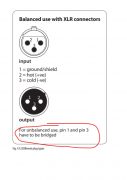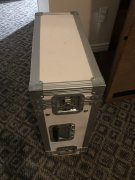grapplesaw
Veteran and General Yakker
Yes in bothYou have the IMD card in one of those?
Yes in bothYou have the IMD card in one of those?
My ancient 1st gen MiniDsp 2x4 does 48dB/octave.The mini-dsp does 96 db/octave?
me too....i read that somewhere ...Low capacitance microphone cable

I'd been working with Glen on a crossover project for the past few weeks, while not as elaborate as what Glen has in the works, it is similar in concept but not using transformers to convert unbalanced to balanced, and back.
I bought a fairly new dbx Driverack PA2 speaker management system as my electronic crossover. Since this is a pro audio system, it has XLR inputs (1 pair, L/R) and XLR outputs (3 pairs, L/R for high, med, low frequencies). My first attempt to connect the RCA outputs from the Carver C1 to the PA2's XLR inputs with a straight wire connection resulted in a significant hiss and high volume level going into the PA2. There is a push button on the back of the PA2 that attenuates the input for +4dBu or -10dBV (HUH??). Turns out the +4dBu is for pro equipment that operates at higher voltages and -10dBV is typically home audio level (one source I read said that it is cheaper to design circuits for lower voltages). Unfortunately, both positions created some really nasty hiss in my perfectly quiet system, just the volume control was useful in different places (7 O'clock in the +4 dBV vs 10 O'clock in the -10 dBV position).
Glen recommended that I consider a Tascam Balance/Unbalanced Line Converter. The LA-80 and LA81 are two options with 8 channels that provide unbal->bal (LA81) OR bal->unbal (LA80). I would have needed both boxes and used 6 channels of each .... but I opted for the LA-40 mk II that does 4 channels each of converting unbalanced to/from balanced. AND each channel has a separate gain trim control that is accessible from the front. THAT is what I ultimately used to tame the hiss for the mid and high crossover channels. I retained the direct wire method for the subwoofer channels and cut the crossover's gain by about 4dB for the low frequency output as the hiss is not detectable from those drivers.
This system is utterly AMAZING ! Neither PL amp is breaking a sweat per the cylons (400-II might break 10 watts, D500 60 watts-100 peaks) and the volume is much louder than I would listen to for long periods of time. Non-fatiguing sound and quality of anything I throw at them sounds incredibly clean.
A little detail about the system config ....
I have a couple pairs of a/d/s/ speakers, both of which are bi-amp compatible; the L1290 and (highly coveted) L1230. I also found (literally roadside) a pair of a/d/s/ L990 3-way speakers a couple years ago which I had all drivers rebuilt and the 10" woofers were modified with 2" magnets and VCs, and new cones. The net result of that mod yielded a woofer like that was used in their S10 double subwoofer offering. Initially tested and built the system with the L1290, but have since disconnected them in favor of the L1230 speakers.
When in bi-amp mode, the L1230 and L1290 woofers are directly driven by the power amp and PA2's mid crossover output, where the mids&tweeters are still connected to the internal crossover, but driven by the external amp and PA2's high outputs.
The L990s had their crossover, mids and tweeters removed; woofers are now driven directly by an external amp & low crossover.
The Dual500 drives the L1230 woofers (they're internally wired in parallel for 4 ohms). The 400-II is driving the L1230's mid&tweeter inputs, and the L990 woofers are driven by the PA2's low crossover output.
The PA2 has parametric equalizers for both the input and each output channel. I have the optional RTA mic that generated the curves automatically by following the 4 mic placements (see pics). The block diagram shows all of the potential functions that can be selected; white highlighted blocks are the ones I have turned on.
The crossover curves are based on the manufacturer specification for crossover frequencies, but with this crossover, I can get 48db/per octave slopes.
View attachment 74714

Not sure if that was for me or Glen, but I confirmed my pins 1&3 are tied together.I've triamped for years with several pro audio xover units and I don't have any problem with hum going from balanced to unbalanced and vice versa - which I have to do to use my equipment with these analog and digital crossovers. I just tie the pin 1 and 3 together as shown below, works fine. I've used the Behringer CX3400, the DCX2496, and the Ashly XR2001 (best of the 3 by far).
Most recently all passive speaker crossover but headed back as I miss it.
View attachment 74721
Got plenty of fans back there. There is a 3/4" gap between the 400-II and PA2 - I formed a piece of rubber sheet over the fan bracket so the air over the heat sinks is directed into this space. That blows air into both the PA2 and through the slits on the top cover of the 400-II.Gear stacked on your amps???? Heat is our enemy.
Not sure if that was for me or Glen, but I confirmed my pins 1&3 are tied together.
The mini-dsp does 96 db/octave?
My ancient 1st gen MiniDsp 2x4 does 48dB/octave.
Two 4x10 HD units sold on eBay in the last month, and there is now two 10x10 HD units for sale from the same seller.
I'm waiting on new production units, that are delayed due to the chip shortage.
dayton 408....analog in/out...4x8....less than 170 bucks....without bt adapter....Waiting to see if the DDRC-88A (analog) resumes production. Currently out of stock, though the DDRC-88D (digital) is still available.
Hoping they come out with a new analog model. They need one.
Worst case, or perhaps the right move, would be to get another cheap used 2x4, two 2x4 units would do it for me.
No versions of the Flex will work for me as I need analog input.







300 watts on those BMS drivers will seriously affect your hearing.Moving on with crossover project after working 3-12 hour days and 8 today. Got offered job to run the company I’m working for but turned them down. Don’t need the headache of managing the new style of workers ie baby sitting
so I got a rane amp today for my center Chanel
it is a fine amp, I have an other. 1800watt in and 6 x105 out or 3x300 in bridged mode or any combination of either. .06% THD+N
so why this
Easy
Balanced inputs
1 amp for three channels
So one rack space
Set up will be 300 watts 15” bass, 300 watts BMS on one of the wooden horns sme two 100 watt for two tweeters
I bought this for $160 including shipping and a beautiful shipping case, which will hold up to a dual 500 Bonus score
Rane is pro audio and industrial finished
It’s good shit
I’ll test on the bench before setting upView attachment 74904View attachment 74905View attachment 74906View attachment 74907View attachment 74908View attachment 74909
Moving on with crossover project after working 3-12 hour days and 8 today. Got offered job to run the company I’m working for but turned them down. Don’t need the headache of managing the new style of workers ie baby sitting
so I got a rane amp today for my center Chanel
it is a fine amp, I have an other. 1800watt in and 6 x105 out or 3x300 in bridged mode or any combination of either. .06% THD+N
so why this
Easy
Balanced inputs
1 amp for three channels
So one rack space
Set up will be 300 watts 15” bass, 300 watts BMS on one of the wooden horns sme two 100 watt for two tweeters
I bought this for $160 including shipping and a beautiful shipping case, which will hold up to a dual 500 Bonus score
Rane is pro audio and industrial finished
It’s good shit
I’ll test on the bench before setting upView attachment 74904View attachment 74905View attachment 74906View attachment 74907View attachment 74908View attachment 74909
300 watts on those BMS drivers will seriously affect your hearing.
